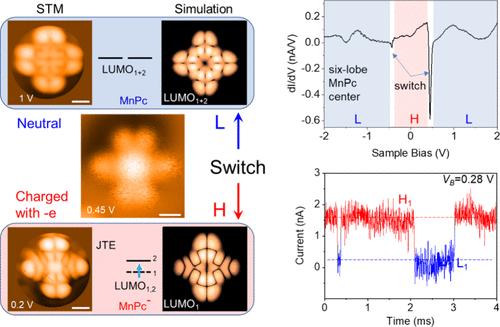具有 Jahn-Teller 畸变的单个锰酞菁分子中的两级电子开关
IF 16
1区 材料科学
Q1 CHEMISTRY, MULTIDISCIPLINARY
引用次数: 0
摘要
了解单分子开关是设计和优化具有高度非线性功能(如栅极电压相关电流开关)的分子电子器件的关键一步。原子级薄绝缘模板与扫描探针技术相结合,是在单分子水平上研究此类开关的理想平台。在本研究中,我们通过扫描隧道显微镜(STM)、光谱学(STS)和理论计算研究了 Rh(111) 上单层薄外延六方氮化硼(h-BN)上的锰-酞菁(MnPc)分子。研究发现了几个有趣的现象:(1)分子轨道的高分辨率 STM 成像揭示了对称性从 D4h 到 D2h 的破坏,在一种 MnPc 中观察到了这一现象。通过与模拟比较,这一现象可归因于分子负电荷导致的 Jahn-Teller 效应。(2) 在固定的样品偏压约为±0.4 V 时,分子上会发生负极跃迁,这在 dI/dV 光谱中表现为负差分电导特征。(3) 随机的两电平切换导致隧道电流中的电报噪声,表现为一个单电子激活过程。我们提出了一个两级开关模型,以准确描述两级之间依赖偏压的电流驱动转变,并揭示了一阶转变。理解和定制超薄绝缘层上的分子开关将对未来的有机电子设计和应用大有裨益。本文章由计算机程序翻译,如有差异,请以英文原文为准。

Two-Level Electronic Switching in Individual Manganese-Phthalocyanine Molecules with Jahn–Teller Distortion
Understanding single molecular switches is a crucial step in designing and optimizing molecular electronic devices with highly nonlinear functionalities, e.g., gate voltage-dependent current switching. An atomically thin insulating template, in combination with scanning probe techniques, is an ideal platform to study such switches on the single-molecule level. In this study, we investigate manganese-phthalocyanine (MnPc) molecules on monolayer-thin epitaxial hexagonal boron nitride (h-BN) on Rh(111) by scanning tunneling microscopy (STM), spectroscopy (STS), and theoretical calculations. Several interesting phenomena are found: (1) high-resolution STM imaging of the molecular orbitals reveals symmetry breaking from D4h to D2h, observed in one type of MnPc. By comparison with simulations, this phenomenon can be attributed to the Jahn–Teller effect due to the negative charging of the molecule. (2) Ambipolar transitions at the molecule occur at fixed sample biases of about ±0.4 V, which manifest as negative differential conductance signatures in dI/dV spectroscopy. (3) The stochastic two-level switching, resulting in telegraphic noise in the tunneling current, manifests as a one-electron activated process. We present a two-level switching model to accurately describe a bias-dependent current-driven transition between the levels and reveal a first-order transition. The understanding and tailoring of molecular switches on the ultrathin insulating layer will be very helpful for future organic electronics design and application.
求助全文
通过发布文献求助,成功后即可免费获取论文全文。
去求助
来源期刊

ACS Nano
工程技术-材料科学:综合
CiteScore
26.00
自引率
4.10%
发文量
1627
审稿时长
1.7 months
期刊介绍:
ACS Nano, published monthly, serves as an international forum for comprehensive articles on nanoscience and nanotechnology research at the intersections of chemistry, biology, materials science, physics, and engineering. The journal fosters communication among scientists in these communities, facilitating collaboration, new research opportunities, and advancements through discoveries. ACS Nano covers synthesis, assembly, characterization, theory, and simulation of nanostructures, nanobiotechnology, nanofabrication, methods and tools for nanoscience and nanotechnology, and self- and directed-assembly. Alongside original research articles, it offers thorough reviews, perspectives on cutting-edge research, and discussions envisioning the future of nanoscience and nanotechnology.
 求助内容:
求助内容: 应助结果提醒方式:
应助结果提醒方式:


